On Friday, May 19, a rare astronomical event will take place, but unfortunately, it won’t be visible to us. It’s called a new Moon. A lunar phase where the Moon is positioned on the dayside and therefore not visible. This particular new Moon is considered even rarer because it is an additional occurrence this season. Giving it the name “Black Moon,” which is the new Moon equivalent of a Blue Moon.
The celestial rhythms don’t align perfectly, as the Moon completes approximately 12.37 orbits around the Earth in a year. While it’s generally accurate to say there is a full Moon and a new Moon each month, we end up with extras. These extras, known as Black and Blue Moons in everyday terms, happen on average every two or three years. More precisely, within almost exactly 19 years and 235 new moons, there are seven extra new Moons. This pattern is known as the Metonic Cycle and forms the basis of many lunar calendars.

Now, let’s clarify what a Blue Moon is
The Moon’s phases have traditionally been used to determine optimal planting and harvesting times. The term “Blue Moon” doesn’t originate from astronomical circles but rather from the 1937 edition of the Maine Farmer’s Almanac. Nowadays, it has two meanings. One refers to the third full Moon in a season that has four full Moons. Typically, seasons have three months and three Moons, but when a season contains four Moons, the third one is called the Blue Moon.
The second meaning relates to the second full Moon in a month, which emerged due to a misinterpretation of the original Almanac reference by J.H. Pruitt in a 1946 edition of the American magazine Sky and Telescope. This definition gained popularity and is still widely used today.
As for the term “Black Moon,” it is relatively recent, originating from Wiccan and astrological circles in the past decade
Similar to the Blue Moon, it doesn’t have a single definition. In one sense, it is considered the opposite of the Farmer’s Almanac’s Blue Moon and refers to the third new Moon of a season. This type of Black Moon occurs approximately every 33 months. Alternatively, according to TimeandDate.com, it can also represent the second new Moon in a month, which happens approximately every 29 months and is slightly more common.

In either case, it’s important to note that the Moon doesn’t change color during these phenomena. It remains neither blue nor black (or pink, for that matter). However, such occurrences provide excellent opportunities for sky viewing since the night sky isn’t illuminated by the brightness of a full Moon.
So, if you’re interested in observing any remaining Eta Aquarids, now is a favorable time to look up. Enjoy the uniqueness of Friday’s event, even though you won’t actually see the spectacle, regardless of which definition you prefer.
Keep Reading: Lunar And Solar Eclipses 2023 – Dates, Folklore, And Facts

